In the 1980s the National Party witnessed a renewed national and international pressure to initiate political reform. The Apartheid government accelerated its homeland policy and the introduction of the Tricameral Parliament gave Coloured and Indian minorities a limited say in running their own “affairs”.
However, the “reforms “ had the opposite effect of what the apartheid regime intended. Oppositional groups began to mobilise and formed the United Democratic Front to oppose the elections for the Tricameral parliamentary elections. There were spontaneous uprisings throughout the country and the apartheid government imposed a series of state of emergencies which lead to the banning and detainment of thousands of activists.
Hundreds of artists and arts and media organisations emerged as part of the nationwide effort to fight the apartheid regime. One of the most celebrated groups to emerge was Afrapix, which came out of an initiative led by veteran artists, photographers and political activists.
In July 1981, at a meeting attended by photographers Omar Badsha, Paul Weinberg, Lesley Lawson, Biddy Partridge, Mxolisi Moyo and Lloyd Spencer, a decision was taken to establish a photographers’ collective. The aim was to establish a photographic collective, a library as well as an agency. The collective also set themselves the aim to organise exhibitions and run photographic workshops for grassroots activists.
By the beginning of 1982, Biddy Partridge, Mxolisi Moyo and Lloyd Spencer left the group and in April 1982, Afrapix became an incubator project of the Inter-Church Media Project (IMP). The IMP provided the photographers with an office, darkroom facilities and a small stipend for full-time staff members. From its inception in 1981 to its closure in June 1991, close to 40 photographers were at one time or another full time, community or associate members of Afrapix. (see list of full and associated members)
1980
• Omar Badsha discussed the need to form a photographers’ collective with Jeeva Rajgopaul and Myron Peters in Durban.
Exhibitions and Publications
• Omar Badsha and Heather Hughes, a lecturer at the then Natal University, compile a travelling exhibition, You Have Struck a Rock: Women and Resistance in South Africa, to mark the first August 9th Women’s Day Celebrations held in the country since the early sixties. Three copies of the exhibition were made and showed in Durban, Johannesburg and Cape Town. The Durban exhibition was held at the Emmanuel Cathedral Hall, in Queen (Dennis Hurley) Street. The government banned all meetings, but the exhibition went ahead.
1981
• In July, Omar Badsha meets with Llyod Spencer, Lesley Lawson, Paul Weinberg, Mxolisi Moyo and Biddy Partridge at the Ravan Press offices in Johannesburg and proposes the establishment of a photographers’ collective. This included a photographic library and the distribution of photographs to the alternative and international press. After listening to the ideas proposed by Omar Badsha, it was agreed that the time had come to establish such a collective.
• Paul Weinberg informed the gathering that he was coordinating an exhibition for the planned Culture and Resistance Conference, which would be held in July of 1982, in Gaborone, Botswana, and that they could exhibit under the auspices of Staffrider Magazine.
• Paul Weinberg and Lesley Lawson volunteered to meet with people at Staffrider Magazine with the proposal to produce a photographic spread for each edition and to establish an annual Staffrider photographic exhibition.
• On his return to Durban, from his trip to Johannesburg, Omar Badsha informed Jeeva Rajgopaul and Myron Peters about his successful meeting with people in Johannesburg who also agreed for the need to form a photographers’ collective.
Members
Omar Badsha, Lesley Lawson, Paul Weinberg, Mxolisi Moyo, Jeeva Rajgopaul, Myron Peters, Peter McKenzie, Cedric Nunn
Exhibitions and Publications
Omar Badsha:
• Market Photographic Gallery, Johannesburg. Solo exhibition.
• University of Durban, Westville. Group exhibition.
1982
• In early 1982, an invitation was sent by Lesley Lawson and Paul Weinberg to urge photographers to submit work to the first Staffrider photographic exhibition.
• Omar Badsha, Paul Weinberg and Lesley Lawson invited photographers to submit work to the Botswana Culture and Resistance Conference, which was organised by MEDU, an artist collective which was largely made up of South African exiles.
• Paul Weinberg and Lesley Lawson met with Bernard Spong, the director of Interchurch Media Project (IMP), to get his support for the establishment of a photographic library/agency. Bernard Spong was enthusiastic about the establishment of a collective and he proposed that the group should become an incubator project of IMP. The incubator project would allow the group to have an office in the Khotso House, the headquarters of the SACC, headed by Desmond Tutu, which would offer administrative support and a stipend for its coordinator(s).
• Bernard Spong immediately began to reach out to local and international NGOs and media groups, informing them of the formation of the group and the idea of an agency/ library to solicit their support.
• Omar Badsha’s photographic darkroom in Good Hope Centre, Queen (now Dennis Hurley Street) becomes Afrapix’s Durban offices.
• In March, Peter McKenzie moved to Johannesburg to join his family. He met with Paul Weinberg and Lesley Lawson and joined the Johannesburg Afrapix team.
• The group now had an office in Khotso House, as well as support to establish the library. Paul Weinberg and Peter McKenzie received a stipend for administrative support to establish the agency office at Khotso House.
• The team put together a brochure that Bernard Spong took with him whilst travelling abroad - Peter McKenzie managed the office and began to structure the IMP slide archive.
• In April, the agency started to function under the name Afrapix, but was still considered an incubator project of the IMP and depended on it for its survival. The agency had a letterhead and press cards became available in August.
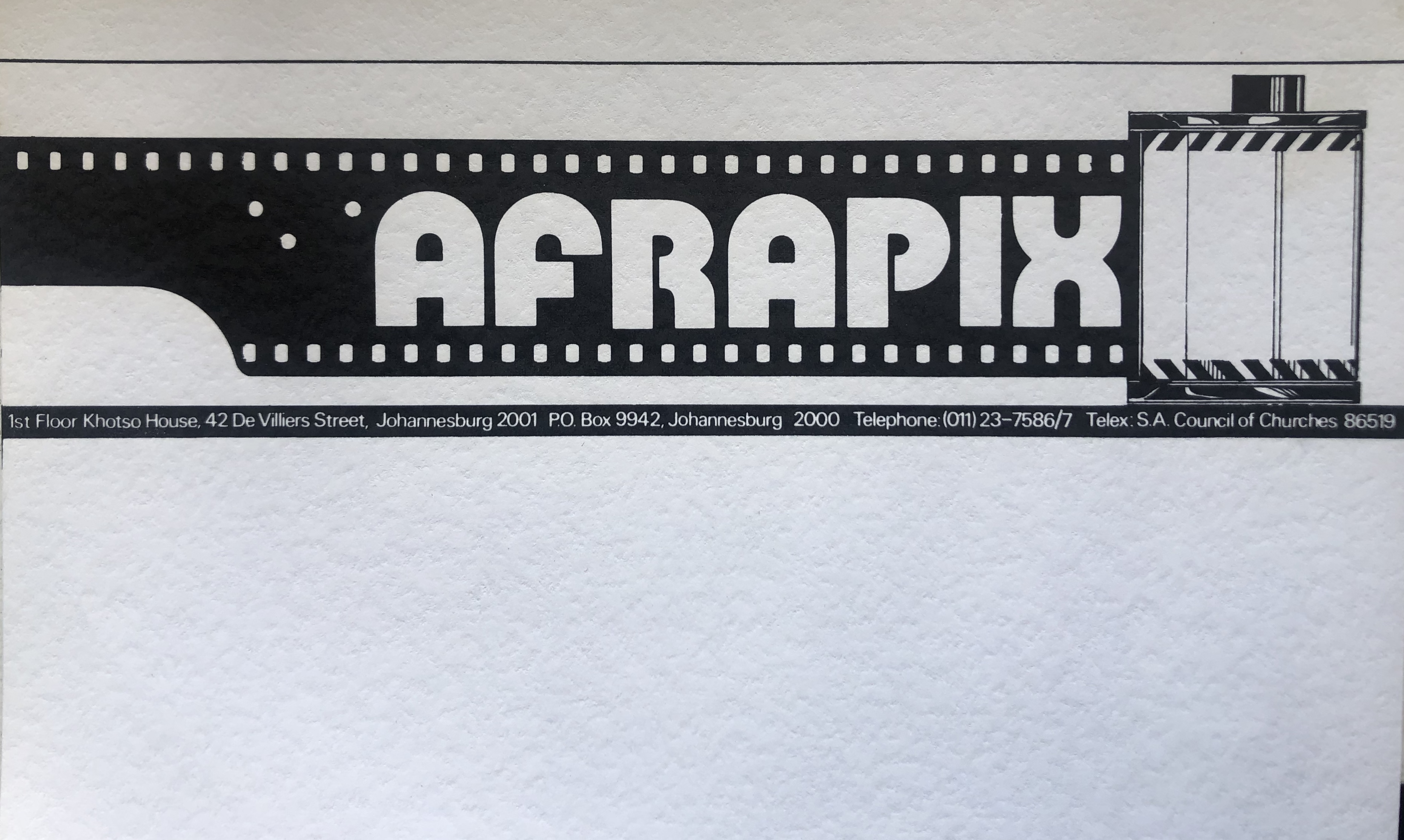
Afrapix Letterhead
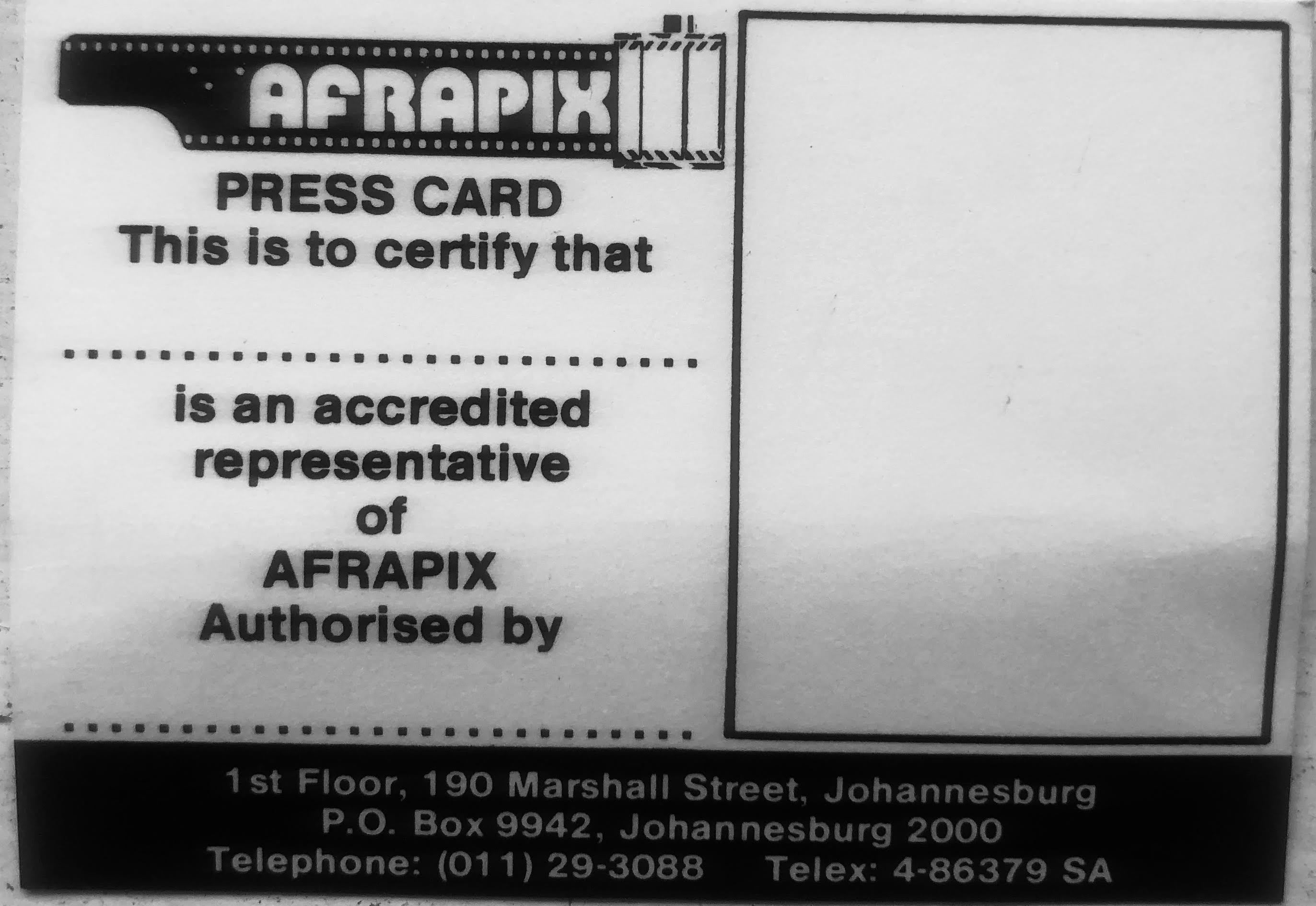
Afrapix Press Card
Carnegie Project
In April 1982, soon after the announcement of the establishment of the Second Carnegie Inquiry into Poverty and Development, Omar Badsha approached the organiser of the project, Prof Francis Wilson from the University of Cape Town (UCT), with a proposal to include photographers to work with researchers on the project. Omar Badsha was appointed as the photographic coordinator of the Inquiry. Omar Badsha then travelled around the country to meet with photographers and look at their work. It soon became apparent that several photographers fell into two categories. The first of the two categories were the white students and lecturers who came from the traditional white universities that had a photographic department and Art as a subject. The second category consisted of black photographers who worked in NGOs or were linked to politically aligned township based cultural groups. Very soon, these groups would become part of a national network of progressive photographers that would go on to exhibit in Staffrider and other exhibitions that would be organised by Afrapix.
• Many of the people who Omar Badsha met with attended the Botswana Conference and were approached to contribute to the Staffrider photographic exhibition.
• In April, Cedric Nunn visited Johannesburg while on his way to Europe and was tasked with networking with photographic agencies in Europe on behalf of the newly established agency, Afrapix.
• Wendy Schewegmann, a friend of Paul Weinberg, who also worked with Weinberg on a film titled, Mayfair, was working for Reuter’s news agency as a photographer at the time. She was invited by Paul to join Afrapix.
• Jeeva Rajgopaul and Myron Peters Durban based community activists and photographers join Afrapix.
• In June, Jimi Matthews, a Cape Town-born photographer, arrived in Durban. He had just completed his studies as a photographer and filmmaker in the United Kingdom (UK) and was invited to join Afrapix. He was also encouraged to recruit members into Afrapix.
• In June, the German photographer, Tim Besserer visited Omar Badsha in Durban. He wanted to compile a body of work consisting of South African photographers, writers, and poets that would showcase in Germany. Thereafter, Tim Besserer joined members of the collective team to attend the Culture and Resistance Conference in Botswana.
Culture and Resistance Conference
In July, The Culture and Resistance Conference was held in Gaborone, Botswana. Paul Weinberg was one of the national coordinators of the photographic section of the festival. Peter McKenzie delivered a paper at the conference.
Culture and Resistance Poster 1982
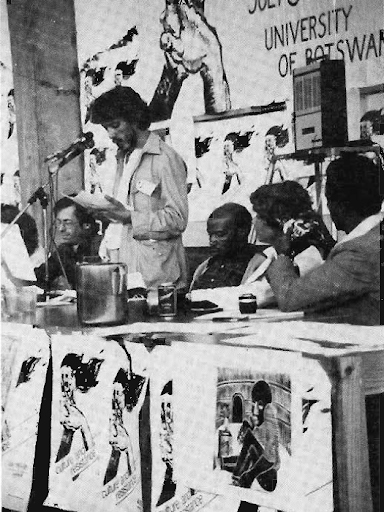
Peter Mckenzie delivering speech at the Culture and Resistance Festival 1982
Members of Afrapix that participated in The Culture and Resistance Conference and Festival: Peter Mckenzie, Lesley Lawson, Jeeva Ragjopaul, Myron Peters, Paul Weinberg
• In the wake of the conference held in Botswana, Afrapix members played a leading role in helping to organise exhibitions as well as mini-festivals in Johannesburg and Durban.
• In August, Afrapix established an international network and proudly announced to its members that it would start functioning with Peter McKenzie as its full-time employee with an administrative office and other support from IMP – it had a logo, printed press cards and a letterhead.
• Omar Badsha attended a meeting of the collective in Johannesburg where a draft of the Afrapix constitution, prepared by Paul Weinberg, was circulated for discussion. It was agreed that the constitution needed work done before it was formally adopted.
• Louise Williams was employed as Afrapix's first full-time administrator.
• Towards the end of 1982, the Afrapix Durban group consisted of Jeeva Rajgopaul, Myron Peters and Cedric Nunn. The Durban branch would later include the following members as part of the collective: Rafs Mayet, Jabulani Sikhakhane, Billy Paddock and Pax Magwaza.
• Afrapix enters into a partnership with the United Kingdom-based Link Picture Library run by Orde Eliason in order to distribute Afrapix images.
Exhibitions and Publications
• June – Lesley Lawson’s exhibition, Survivors, opened at the Market Photo Gallery.
• The Culture and Resistance Conference - Members of Afrapix that participated in The Culture and Resistance Conference and Festival: Omar Badsha, Peter Mckenzie, Lesley Lawson, Jeeva Rajgopaul, Myron Peters and Paul Weinberg
• Omar Badsha held an exhibition at the Market Photographic Gallery in Johannesburg.
• On the 6th of September – Omar Badsha's exhibition, Imperial Ghetto, opened at the Nuffield Gallery in Durban.
• Omar Badsha organized an exhibition at the University of Durban in Westville.
• Omar Badsha participated at the Cultural Festival in the Bosmont Township, Johannesburg. Group exhibition.
• Omar Badsha participated at the Cultural Festival, organized at the University of Natal, at the Allan Taylor Residence, KwaZulu Natal.
• Omar Badsha participated at the We Photograph show, Durban Municipal Art Gallery (DMAG), Durban. Group exhibition.
• Omar Badsha participated in South Africa: Photo Statements, held at the South African National Gallery, in Cape Town, and a National Touring Exhibition. Group exhibition.
South Africa: Photo Statements Poster 1982
Members
• Omar Badsha, Paul Weinberg, Lesley Lawson, Peter McKenzie, Jeeva Rajgopaul, Myron Peters, Wendy Schwegmann, Mxolisi Moyo, Joe Alfers, Kentridge and Jimi Matthews.
• Durban Members: Omar Badsha, Jeeva Rajgopaul, Myron Peters, and Cedric Nunn.
1983
• At the beginning of January, Omar Badsha attended a meeting of the TIC (Transvaal Indian Congress) held at the Johannesburg City Hall. An announcement was made by Rev. Allan Boesak to establish the United Democratic Front (UDF). What was set in motion that day marked the beginning of a new mass political movement for change. There had been a flurry of activity in the entire province to establish committees and to send delegates to the UDF conference in Cape Town.
• February – after Cedric Nunn returned from his European endeavour, he started his career as a professional photographer. He ran the Afrapix office in Johannesburg and started filling in for photographers.
• Omar Badsha, Paul Weinberg, and Chris Van Wyk met to select images for the first Staffrider photographic exhibition, which had been a joint Afrapix and Staffrider project.
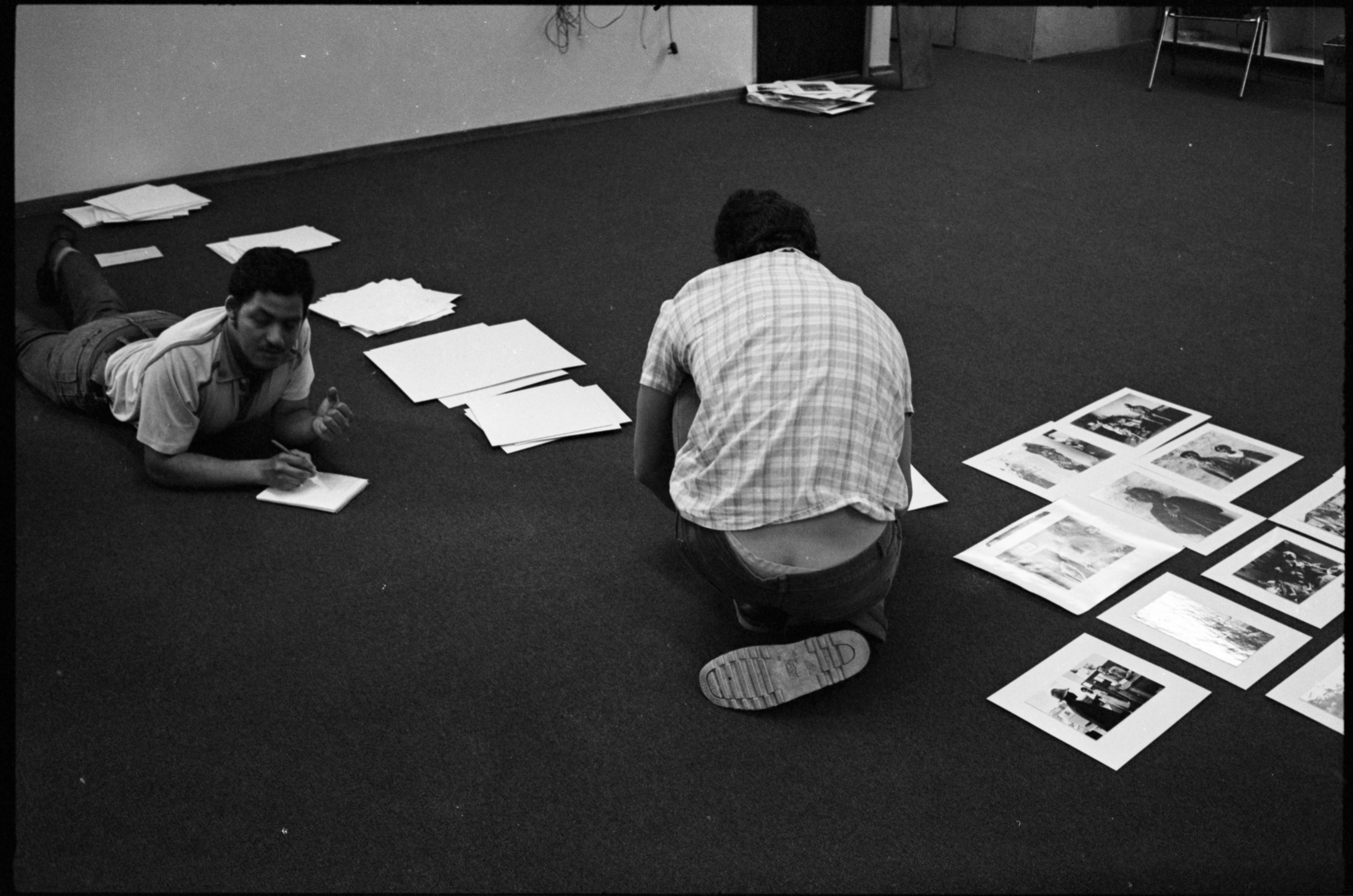
Paul Weinberg and Chris Van Wyk selecting images for the first Staffrider exhibition 1983
• That same weekend, on the 26th of June, Afrapix held its first annual general meeting. After the meeting, members of the collective attended the launch of the first Staffrider exhibition titled, South Africa: Through the Lens. The exhibition had attracted 24 photographers who submitted 300 prints. These prints were edited down to 100. The exhibition ran at the Market Photo Gallery and then moved on to showcase in Durban.
First Staffrider exhibition poster 1983
Afrascope
• Afrascope was an independent committed video group dedicated to news and challenging productions appropriate to the social realities of Southern Africa. It began to function as a film and video incubator project of the IMP. Afrascope started by covering political meetings, protests and strikes. Bernard Spong involved Paul Weinberg to assist in the formation of Afrascope, which was headed by Calvin Prakasim as director. Later, Chris Ledochowski also joined the group.
• Cecil Sols and Vuyi Mbalo joined Afrapix and set about to help establish a branch of Afrapix as well as a training workshop in Soweto. They both had received scholarships to study in Italy.
• August – some Afrapix photographers from Durban and Johannesburg travelled to Cape Town to cover the launch of the UDF. Jimi Matthews, just before the launch, chose to resign from Afrapix and started working as a fulltime news cameraman. Afrapix photographers had pulled off a major coup when on Sunday morning delegates were able to read the City Press coverage of the launch.
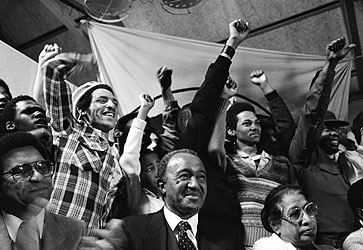
Dr Alan Boesak, Archie Gumede and Mrs Naicker at the launch of the UDF. © Omar Badsha 1983
• Chris Ledochowski joins Afrapix.
• Rafs Mayet started working with Omar Badsha at the Afrapix office in Durban.
• Billy Paddock was released from Pretoria Central after serving a year for refusing to serve in the army. He had been a conscientious objector and started working as a photographer with Omar Badsha in the Afrapix office in Durban.
• Omar Badsha and Paul Weinberg covered the clash between students and Inkatha Freedom Party (IFP) members at Ngoyi University, Zululand, Natal (now KwaZulu-Natal). Strini Moodley also covered the event for the Graphic newspaper. The IFP threatened to sue the City Press as well as Omar Badsha and Paul Weinberg for the report that they had written on the clash, but nothing came of this.
• Omar Badsha started working with Ari Sitas and Astrid von Kotze on the Culture and Working Live Project along with workers from the Dunlop factory, who had been on strike, and later with workers from the Sarmcol factory in Howick, outside Pietermaritzburg, which he was involved in organizing in 1973/74.
• Peter McKenzie left Afrapix and took over Paul Weinberg’s job as a stringer for the Sunday Tribune.
• Wendy Schwegmann leaves South Africa to work for Reuters in the United Kingdom.
• Jabulani Sikhakhane worked with Omar Badsha and became part of the Natal Afrapix team.
Members
• At the end of 1983, Afrapix consisted of Omar Badsha, Paul Weinberg, Lesley Lawson, Mxolisi Moyo, Biddy Partridge, Myron Peters, Jeeva Rajgopaul, Cedric Nunn, Cecil Sols, Vuyi Mbalo, Joe Alfers, Billy Paddock, Rafs Mayet, Jabulani Sikhakhane and Herbert Mabuza.
Exhibitions and Publications
• 31 January – 4th February, Paul Weinberg exhibited Side by Side, an essay on Mayfair, a multiracial Johannesburg suburb at the Wits History Workshop Conference.
• The exhibition and publication Nichts Wird Uns Trennen (Nothing Will Separate Us), by Dieter Koeve and Tim Besserer, was launched in Germany. It featured the work of 27 photographers from Afrapix. The photographers were: Paul Alberts, Joe Alfers, Omar Badsha, Bee Berman, Harold Carlsson, Mark van Dyk, Ivan Giesen, David Goldblatt, Natalie Goldsmith, Glynn Griffiths, George Hallett, Paul Konings, Lesley Lawson, Ben McLennan, Jimi Matthews, Peter McKenzie, Juda Ngwenya, Cedric Nunn, Myron Peters, Jeeva Rajgopaul, Struan Robertson, Tom Robertson, Kevin Rudham, Karl Sansom, Philip Schedler, Paul Weinberg and Morris Zwi.
• June - The first Staffrider exhibition titled,South Africa: Through the Lens had attracted 24 photographers who submitted 300 prints. These prints were edited down to 100. The exhibition ran at the Market Photo Gallery and then moved on to showcase in Durban.
• Omar Badsha's exhibition, Imijondolo, opened at the Market Photo Gallery in Johannesburg.
• Omar Badsha’s Imijondolo exhibition opens at the Merebank Public Library, Durban.
• Peter McKenzie and Omar Badsha were invited to exhibit at the Botswana National Gallery.
• Omar Badsha exhibited at the History Conference, held at the University of Natal in KwaZulu-Natal.
• 6 September – Omar Badsha's exhibition, Imperial Ghetto, opened in Durban.
1984
• In January, Gille De Vlieg, a member of the Black Sash (an organisation which also had its offices in Khotso house) joined Afrapix.
• Pax Magwaza was arrested in the wake of popular resistance against apartheid after the assassination of Msizi Dube, the Lamontville community leader.
• David Hartman joined the photographic collective, Afrapix, of which he was a member until 1988 before emigrating to Canada. Along with Chris Ledochowski and Paul Grendon, Hartman formed part of the Cape Town Afrapix branch.
• In May, Omar Badsha travelled to Johannesburg with Paul Weinberg and Chris Ledochowski to attend the second Staffrider exhibition held at the Market Photo Gallery. The photographs were edited and hung on the 1st of June. The exhibition ran until the 21st of June. The catalogue South Africa: Through the Lens was launched at the opening.
• On the 9th of October, the security police mounted a major raid on the IMP, Afrapix and Afrascope offices. Most of the IMP and Afrapix material were confiscated and later returned. Calvin Prakasim of Afrascope was detained under "Section 29" and held by the police for questioning.
Exhibitions and Publications
• Paul Weinberg was a consultant on the film And Now We Have No Land.
• 90 Fighting Years - a photographic history of the Natal Indian Congress compiled by Omar Badsha and Roy Padayachie is published by the Natal Indian Congress (NIC), marking its 90th birthday celebrations. The event is held at the University of Natal.
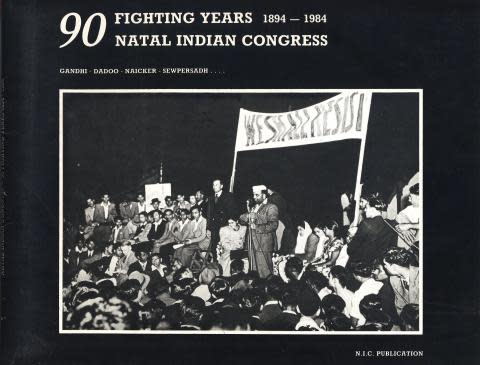
90 Fighting Years (1984)
• On the 1st of March, the photo exhibition, Nichts Wird Uns Trennen (Nothing Will Separate Us), opened in Frankfurt, Germany after three years of preparation. It presented 191 black and white prints and 24 additional text-boards with information about the photographers and their work. In the spring of 1985, a second improved edition of the book was produced.
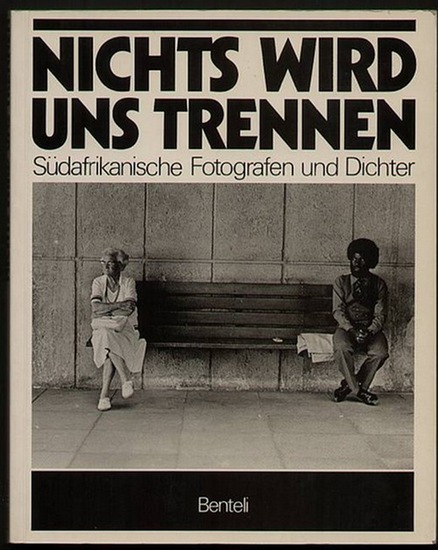
Nichts Wird Uns Trennen (1984)
The exhibition was edited by Tim Besserer, Dieter Koeve, Deutscher Werkbund, Medico-International and the Lutheran Church of Germany.
Photographers that contributed to the exhibition: Paul Alberts, Joe Alfers, Omar Badsha, Bee Berman, Harold Carlsson, Mark van Dyk, Ivan Giesen, David Goldblatt, Natalie Goldsmith, Glynn Griffiths, George Hallett, Paul Konings, Lesley Lawson, Ben McLennan, Jimi Matthews, Peter McKenzie, Juda Ngwenja, Cedric Nunn, Myron Peters, Jeeva Rajgopaul, Struan Robertson, Tom Robertson, Kevin Rudham, Karl Sansom, Philip Schedler, Paul Weinberg and Morris Zwi.
• 10 April - The Carnegie Conference and the photographic exhibition, South Africa The Cordoned Heart opened at the University of Cape Town.
• 1 June - 21 June Staffrider Annual Exhibition organized by Staffrider and Afrapix held at the Market Photo Gallery, Johannesburg. Exhibitors included: Paul Alberts, Omar Badsha, David Goldblatt, Mxolisi Moyo, Judas Ngwena, Jeeva Rajgopaul, Bee Berman and Paul Weinberg
• 24 July - Omar Badsha and Paul Weinberg held a joint exhibition at the Natal Society of Arts Gallery, Overport. Billy Nair, South African Communist Party activist and ex-Robben Island prisoner opened the exhibition.
• In the July/ August issue, Creative Camera carried a special feature on South Africa as well as an article on Afrapix entitled, Going beyond the Image, which included photo-essays by Paul Weinberg and Omar Badsha.
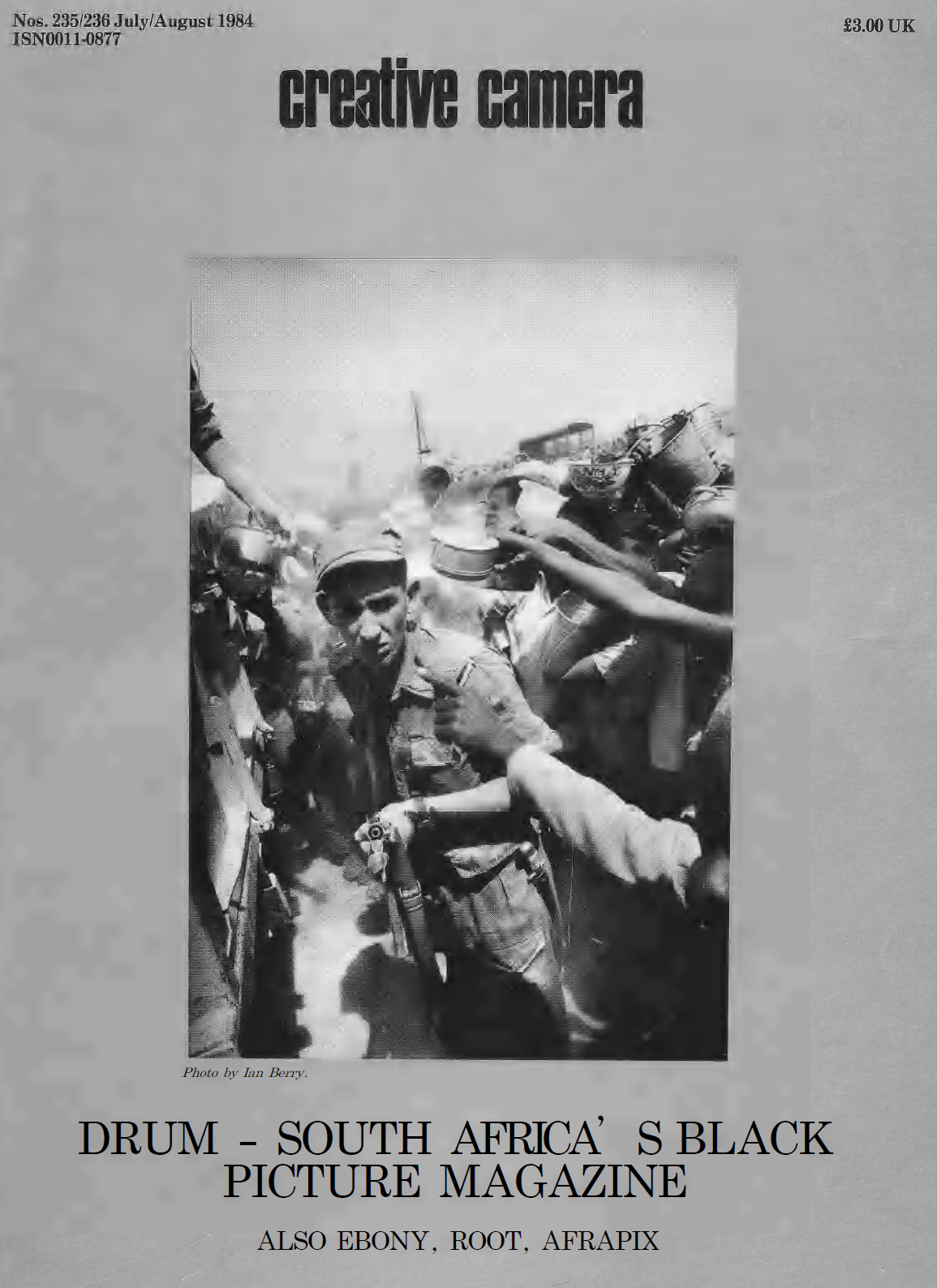
Creative Camera Nos. 235/236 July/August 1984
• Myron Peters’ photographs are published in Fatima Meer’s, Factory and Family: The Divided Lives of South Africa's Women Workers, Institute for Black Research, Durban.
• Reuters photographer and Afrapix member, Wendy Schewegman, leaves South Africa to work for Reuters in the United Kingdom.
• 8 October: Security police raided Afrapix and other organisations such as Afrascope and IMP that had offices in the Khotso House. Scores of anti-apartheid organisations were raided all around the country.
Members
Omar Badsha, Paul Weinberg, Myron Peters, Jeeva Rajgopaul, Cedric Nunn, Cecil Sols, Vuyi Mbalo, Billy Paddock, Rafs Mayet, Gille de Vlieg, Jabulani Sikhakhane and Herbert Mabuza.
1985
• Afrapix produced a calendar to mark the Year of the Youth.
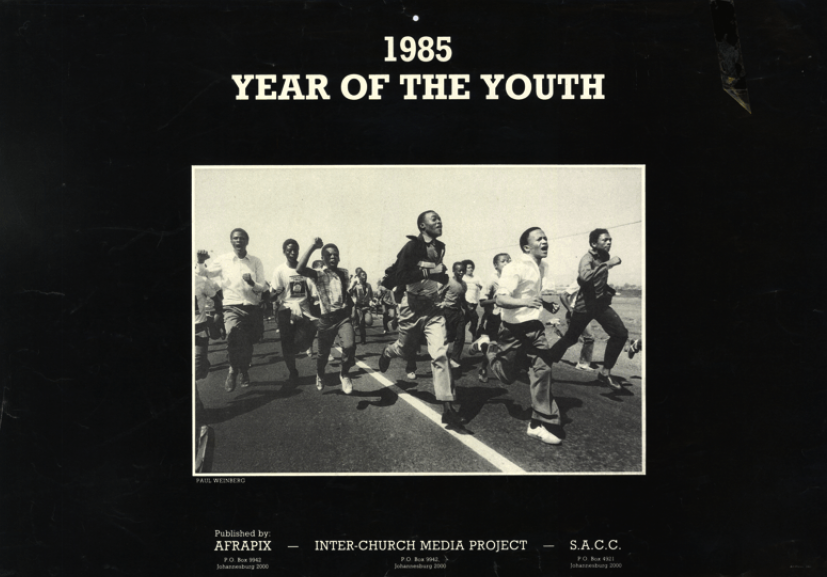
Year of the Youth Calendar 1985
• 8 January - Omar Badsha, Paul Weinberg and Chris van Wyk (the editor of Staffrider magazine) invited photographers to submit their work for the Staffrider Annual Photographic Exhibition. The theme that year was, The Year of the Youth, which was also the ANC's theme for 1985.
• Staffrider exhibition opened and Afrapix AGM was held in Johannesburg.
• David Goldblatt approached Omar Badsha to invite Santu Mofokeng to join Afrapix.
• April/May of 1985, Afrapix moved its offices from Khotso House into the same premises as the Weekly Mail in central Johannesburg. The Weekly Mail also housed other alternative media agencies and design studios (address). Afrapix agreed to provide the newly launched newspaper, Weekly Mail, with photographs.
• 13 June - the first issue of Weekly Mail appeared and featured the works of Afrapix photographers.
• 20th July: A national State of Emergency was declared in the country. Ultimately the Emergency regulations prohibited photographers and journalists from even being present when police acted against protesters and other activists. Those who dared to expose the daily nationwide brutality by security forces risked being jailed. Many photographers, journalists and activists nevertheless felt duty-bound to show the world just how the iron fist of apartheid dealt with opposition.
• Santu Mofokeng joined the Afrapix Collective and started shooting pictures of the anti-apartheid struggle.
• Anna Zieminski moved from Cape Town to Johannesburg to pursue a career as a freelance photographer.
• Paul Weinberg and Santu Mofokeng started work on a joint project titled, Going Home.
• Pax Magwaza was granted bail and leave of appeal as he was charged together with others for the murder of Sash Kanyile and sentenced to 8 years imprisonment. He was released from prison and served as an apprentice to Omar Badsha. He also became a member of the Durban Afrapix Collective.
• Cedric Nunn moved from Johannesburg to Mangete in Natal. He worked at the Afrapix offices until 1987 and then moved back to Johannesburg to help out with the local family store. This marked a difficult period due to heightened police surveillance.
• Rafs Mayet was admitted as a member of Afrapix at the 1985 AGM.
• In September, Peter Auf de Hyder joins Afrapix.
Exhibitions and Publications
• Omar Badsha’s book, Imijondolo - A Photographic Essay on Forced Removals in Inanda, Natal, was published by Afrapix.
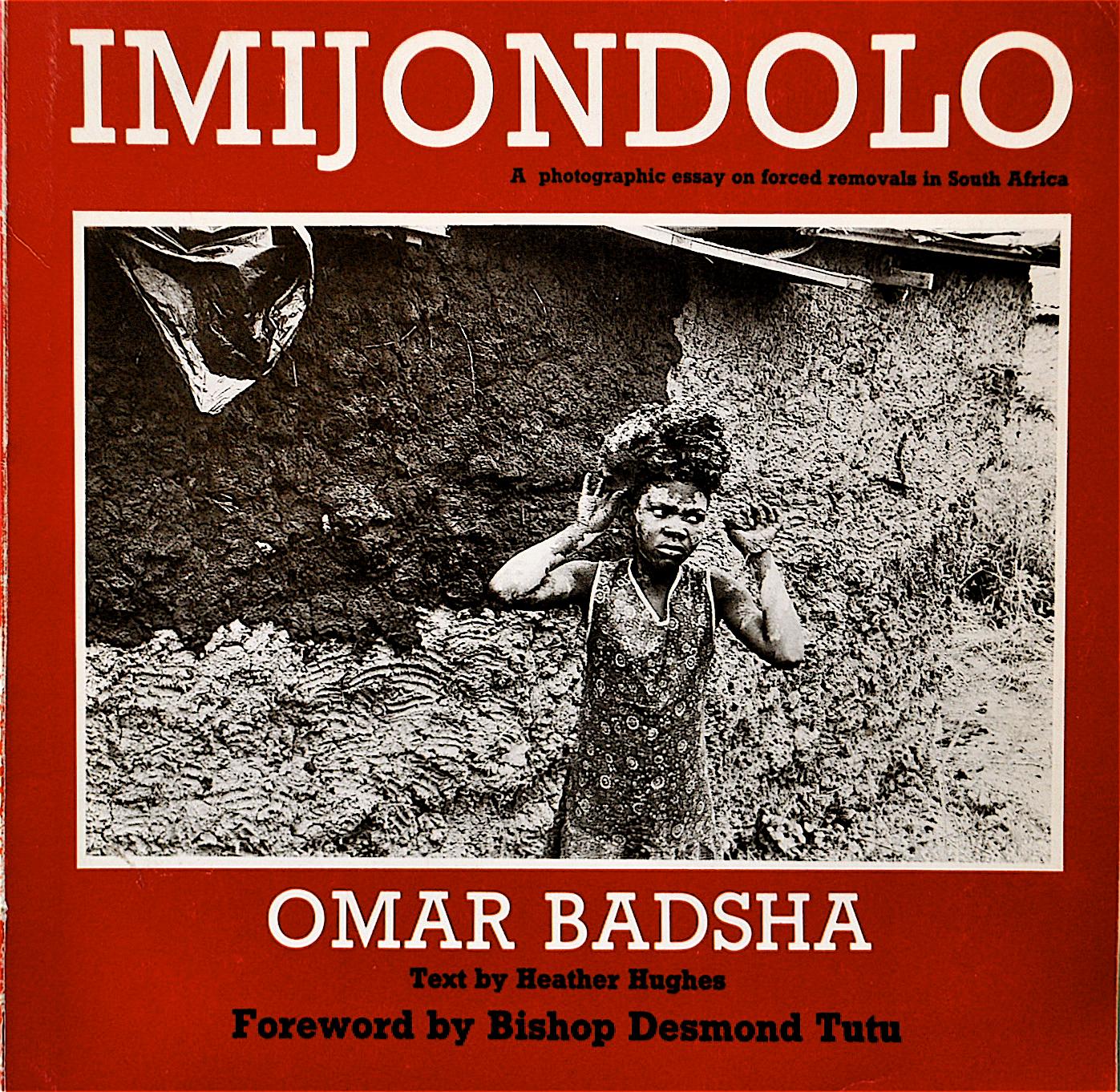
Imijondolo (1985)
• Alex Harris and his partner Margret Sartor arrived in South Africa and travelled with Omar Badsha to meet and interview photographers. They worked with Omar Badsha and assisted in printing of the exhibition, as well as designing the book, South Africa: The Cordoned Heart.
• Lesley Lawson's book of photographs and interviews Working Women, was published by Sached and Ravan Press.
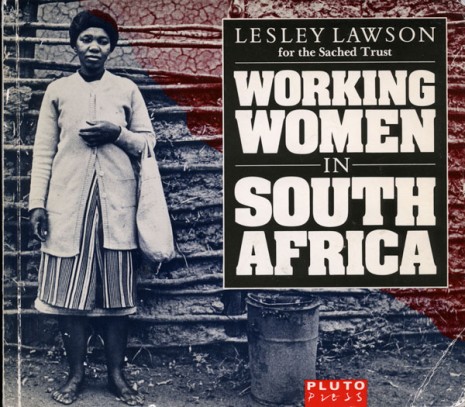
Working Women (1985)
• South Africa: Who Cares is published by Gallery Press and features the works of Paul Alberts, Bee Berman, Patrick Royal, Paul Weinberg, Ray Hartman and Giselle Wulfsohn.
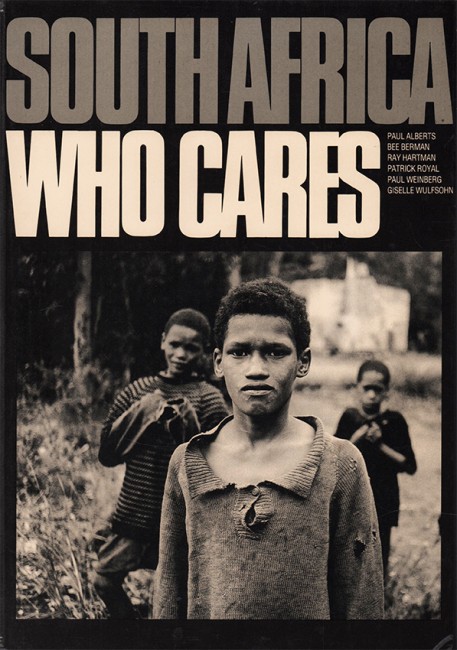
South Africa: Who Cares (1985)
• 17 June to 6th July - The Annual Staffrider exhibition, edited by Omar Badsha, Paul Weinberg and the writer Chris Van Wyk, opens at the Market Gallery, Johannesburg.
Members
• Paul Weinberg, Santu Mafokeng, Rafs Mayet, Omar Badsha, Myron Peters, Jeeva Rajgopaul, Cedric Nun, Cecil Sols, Vuyi Mbalo, Billy Paddock, Jabulani Sikhakhane, Chris Ledochowski, Herbert Mabuza, Steve Hilton Barber and Peter Auf de Hyder.
1986
• On the 24th of February, Afrapix was registered as a CC with Omar Badsha and Paul Weinberg as directors. The most important aspect of Afrapix becoming a CC was for legal and trading purposes.
• 1 March - At the Afrapix AGM meeting, an issue was raised with the members of the Soweto Afrapix branch, namely Vuyi Lesley Mbalo and Cecil Sols, regarding their acting independence from the central Afrapix branch based in Johannesburg. Specifically, members of Afrapix were uncomfortable with their separate fundraising activities.
• The South African government refused Omar Badsha a passport to travel to New York, United States of America (USA) to attend the opening of his exhibition and the book launch titled, South Africa: The Cordoned Heart. Omar Badsha’s wife, Nasima Badsha and their daughter, Farzanah, along with Paul Weinberg, attended the book and exhibition launch in New York. Nasima Badsha and Paul Weinberg spoke at a seminar which formed part of the exhibition.
• Members of the Natal Afrapix held workshops and collaborated with organisations such as Diakonia, Congress of South African Trade Unions (COSATU), and the Culture and Working Life Project.
• Omar Badsha designs cover of the book Black Mamba Rising.

Black Mamba Rising book cover by Omar Badsha 1986
• June - Sandi Smit, 24, ECC media committee member, JODAC member, Afrapix photographer; detained on June 15 and released on June 29.
• Guy Tillim joins Afrapix, working with the collective until 1990.
• Gille de Vlieg, a Black Sash rep to ECC; Afrapix photographer; detained on the 12th of June after a raid on her house, initially under Section 50 of the Internal Security Act, and taken to John Vorster Square and then to the Hillbrow police station for thirty-seven days.
• Pax Magwaza lost his appeal and went back to serve his prison sentence. He lodged another appeal to the Supreme Court Appellate Division and was again released on bail. He continued working as a photographer and member of Afrapix.
• July - Afrapix held a special meeting to discuss funding they had received by Cecil Sols and Vuyi Mbalo for their Soweto project. Afrapix felt uncomfortable with the funds –Cecil Sols and Vuyi Mbalo left Afrapix and set up Photographers for Social Documentation (Photosdoc) in Soweto (Vuyi and Cecil were still considered contributors towards Afrapix). In July, Cecil Sols and Vuyi Mbalo ran the Soweto branch of Afrapix for a short period.
• July - Afrapix members David Hartman, Gille de Vlieg and Sandi Smit together with Zwelakhe Sisulu (who was the editor of New Nation) are released from detention.
• On the 4th of October, a special meeting was held at Gisele Wulfsohn’s apartment. Afrapix holds special crisis meeting to discuss the State of Emergency and the implications for the collective, its financial position and the relationship it had with other groups around the country
• Herbert Mabuza joins City Press and is no longer active in Afrapix.
Exhibitions and Publications
• 9 February, Wits History workshop, Johannesburg, Paul Weinberg had an exhibition, Street Musicians.
• Paul Weinberg started his project on the socio-economic conditions of the Bushman communities of Namibia. A proposal was sent out to help raise funds for the project. Paul Weinberg then curated the exhibition on the Bushman which was called, Shaken Roots – Some Experiences of the San People. The exhibition opened at the Johannesburg Market Gallery on the 6th of April. Other photographers involved in the exhibition were Orde Eliason, Dr. Fourie and Jurgen Schadeberg.
• Staffrider published images from its 1985 exhibition Images of Youth in its Staffrider Vol.6 No.3 1986 https://www.sahistory.org.za/archive/staffrider-vol6-no3-1986

Images of Youth - Staffrider Vol.6 No.3 1986
• Santu Mofokeng spends a few weeks photographing Train Church, his ongoing exploration of religious rituals, and the displacement of places of worship which would later be considered his first photographic essay.
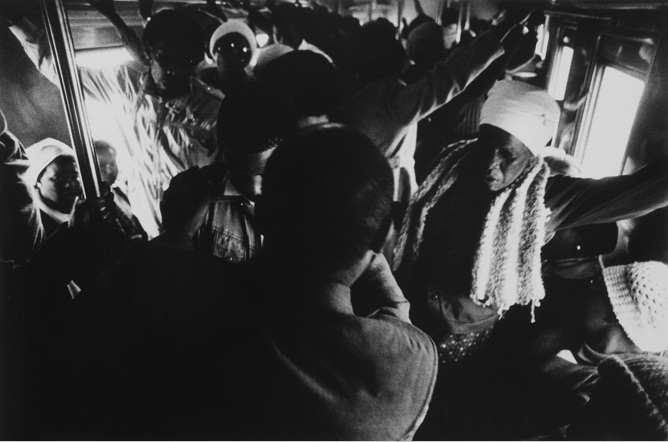 Train Church by Santu Mofokeng (1986)
Train Church by Santu Mofokeng (1986)
• On the 4th of May, 1986, the photography exhibition and book, The Cordoned Heart opened in New York at the International Centre for Photography (ICP). Publication of the Carnegie Commission book: South Africa, The Cordoned Heart. The book was edited by Omar Badsha and featured 20 photographers, many of whom were Afrapix members. The Cordoned Heart exhibition toured America for close to four years. A copy went to the UK, as well as Germany, and travelled through other European countries.
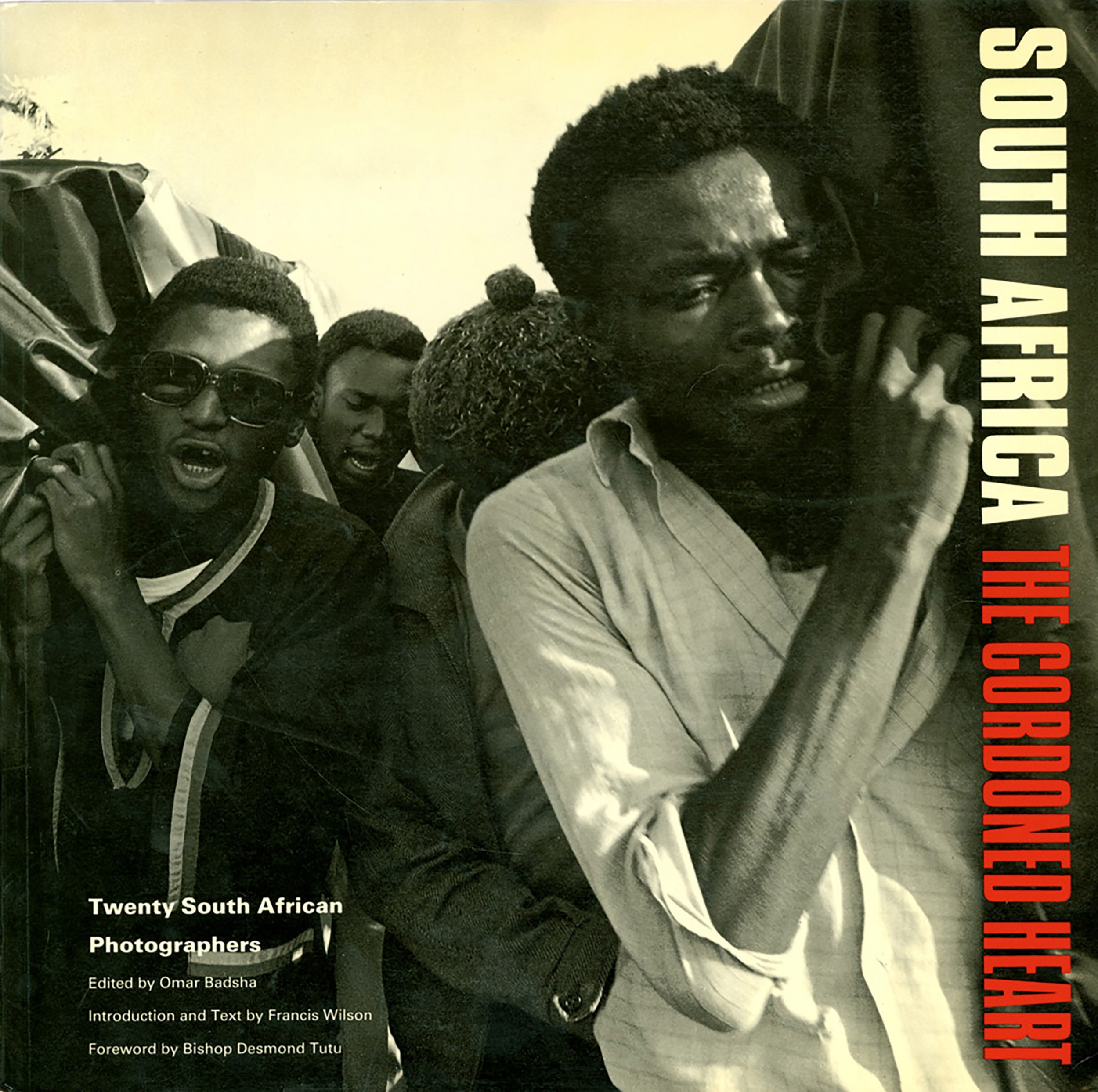
South Africa - The Cordoned Heart (1986)
• Afrapix compiled an exhibition, Taking Sides. Conflict in South Africa 1984-1986. An Afrapix Exhibition, which was commissioned by Oxfam, in Canada. Photographers include Steve Hilton-Barber, Orde Eliason, Vuyi Mbalo, Paul Weinberg, Omar Badsha, Julian Cobbing, Billy Paddock, Gill de Vlieg, Eric Miller, Dave Hartman, Cecil Sols.

Taking Sides: Conflict in South Africa 1984-1986
• The annual Staffrider photographic exhibition is held at the Market Gallery.
• Paul Weinberg and Rob Nixon published an article on the Afrapix Collective in the August edition of Our Times magazine.
• EDA (Environmental Development Agency) and Afrapix put together a calendar titled Working Together
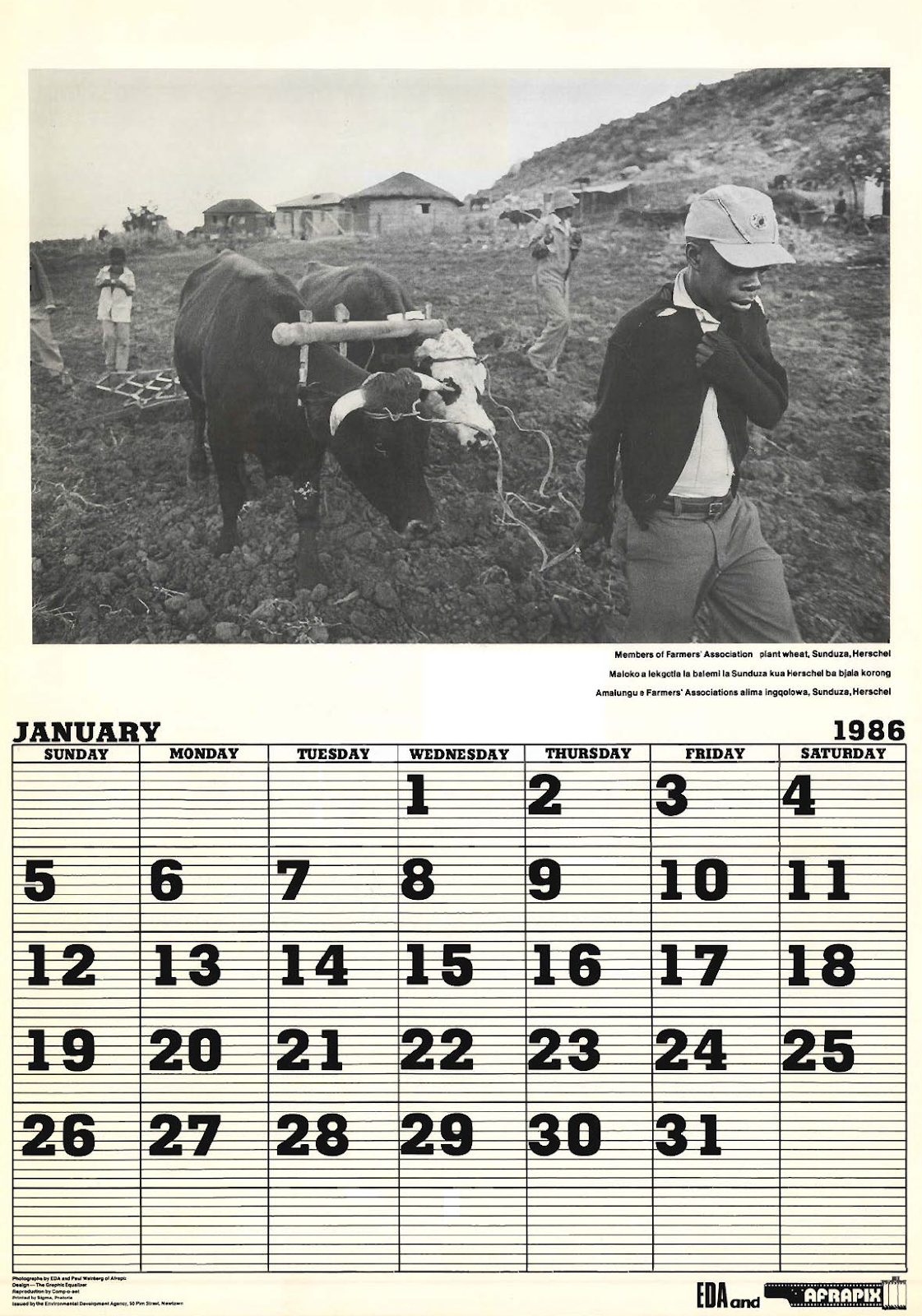
Working Together - EDA and Afrapix Calendar 1986
Members
Omar Badsha, Paul Weinberg, Cedric Nunn, Santu Mofokeng, David Hartman, Gille de Vlieg, Chris Ledochowski, Sandi Smit, Guy Tillim, Peter Auf der Heyde, Eric Miller, Steve Hilton Barber, Myron Peters, Jeeva Rajgopaul, Joe Alphers, Rafs Mayet, Pax Magwaza, Billy Paddock, Chris Qwazi, Sandy Smit, Anna Zieminski, John Liebenberg
1987
• Gisele Wulfsohn, the former chief photographer of Leadership magazine, went freelance and joined Afrapix.
• Omar Badsha moved to Cape Town to head the newly established Centre for Documentary Photography at the University of Cape Town (UCT).
• On the 14th of March, Afrapix held its annual general meeting at the Koinonia Church in Judiths Paarl, Johannesburg.
• April 11- Visnews cameraman, Rob Celliers, and his sound recorder, Dave Copeland as well as Reuters photographer, Wendy Schwegmann, were arrested and their cameras confiscated while covering a mine disaster. They were charged with trespassing and for photographing bodies before a post-mortem.
• 12 April - Rhodes University officials used an electric cattle prodder on CBS cameraman George Luse and Reuters photographer Steve Hilton-Barber whilst covering a demonstration at a post-graduation garden party.
• Roger Meintjies joins Afrapix
• Pax Magwaza joins Afrapix
• In December, Zubeida Vallie, Vuyi Mbalo, Jeeva Rajgopaul, and Paul Weinberg formed part of the South African photographic delegation to the Culture in Another South Africa (CASA) Conference which was hosted by the Dutch Anti-Apartheid Movement in Amsterdam, Netherlands. Herbert Mabuza was also present at the conference and Morris Zwi joined them from London.
• Chris Ledochowski continued his relationship with SALDRU and UCT and worked on Atlantis, The Utopian Nightmare and Mbekweni, Paarl. Two photo essays at Documentary Photography in South Africa, Exhibition and Conference, Centre for Documentary Photography, University of Cape Town.
• Santu Mofokeng became a full-time employer at the New Nation newspaper and worked there for just over a year.
• By 1987 the Afrapix offices in Cape Town were fully functional. Guy Tillim and Dave Hartmann became part of the Afrapix group.
Exhibitions and Publications
• 26 January– 16 February 1987: Taking Sides showcased in South Africa at the McPherson Library Gallery. The exhibition featured twenty-five 16×20 black and white photographs taken by members of Afrapix, South Africa’s first non-racial photographer’s co-op. These photographs evoked the spirit of the anti-apartheid movement in the hopes that a new society, responsive to the black majority, could be built in South Africa.
• 14 February, Paul Weinberg and Omar Badsha held an exhibition at Wits History Workshop.
• On the 7th of June, an exhibition by Dave Hartman and Guy Tillim titled, Crossroads, is held at The Market Photo Gallery in Johannesburg.
• Afrapix put together an exhibition, Women at Work, a study on Domestic Workers, held in Johannesburg. Photographers: Gisele Wulfsohn, Paul Weinberg, Santu Mofokeng, Dave Hartman, and Guy Tillim
• Afrapix put together an exhibition, Children on The Frontline, which was edited by Omar Badsha. The exhibition also showcased in Cape Town under the title, Free the Children’s Alliance which ran from 17 - 20 December.
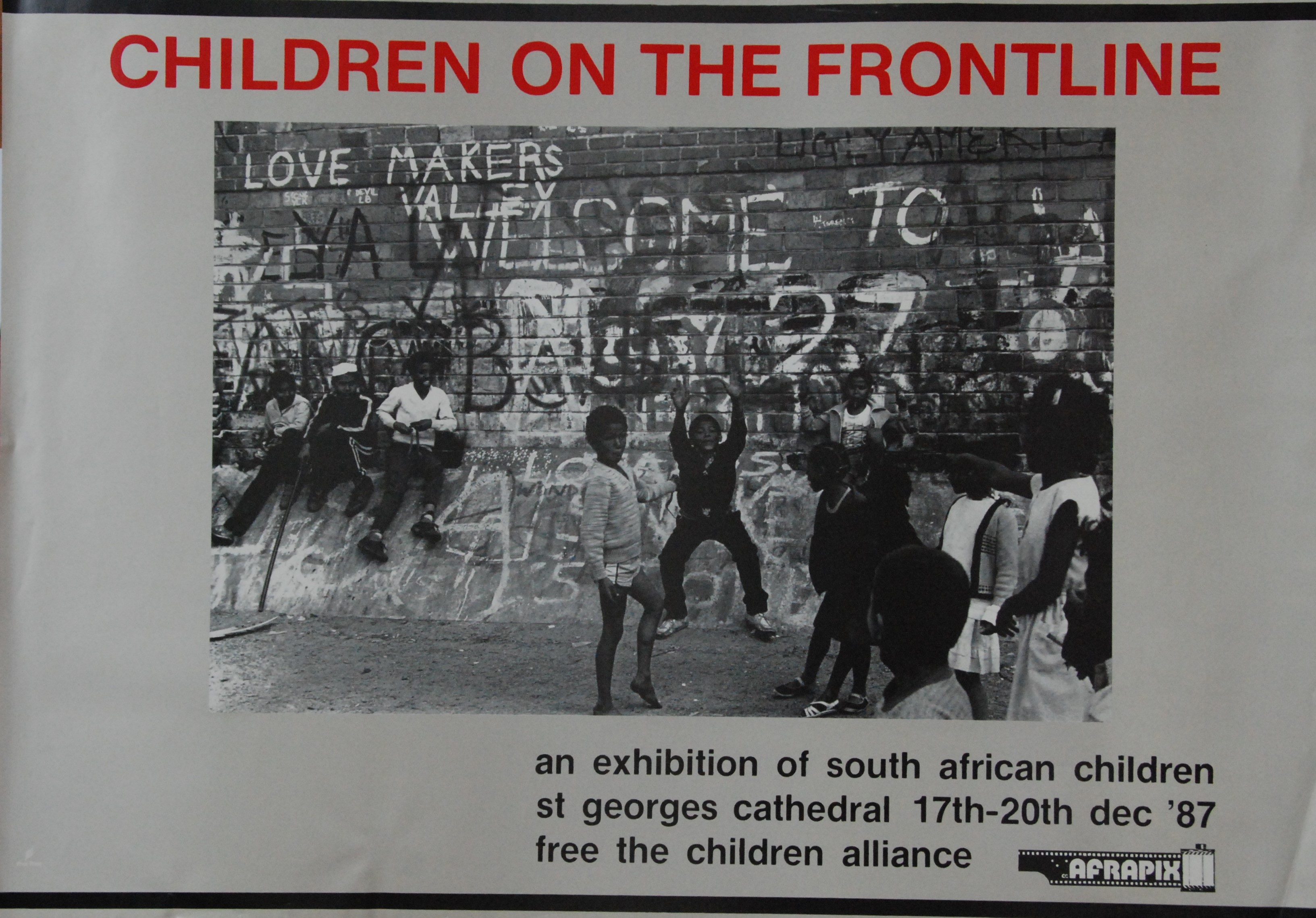
Children on the Frontline 1987
• Staffrider annual exhibition changed its format (print letter).
• Santu Mofokeng exhibited his essay, Train Culture, at the annual Staffrider exhibition.
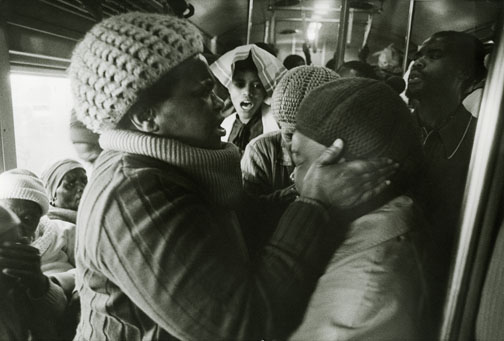
Santu Mofokeng's Train Culture 1987
• Paul Grendon had published his photographs from Namaqualand in an article in the Weekly Mail.
• Exhibition - The Finest Photos from the Old Drum opens at Shell Gallery, Cape Town; Durban Museum, Durban; Market Gallery, Johannesburg; South Africa.
• Eric Miller's book titled, Thula Baba, is published by Ravan Press.
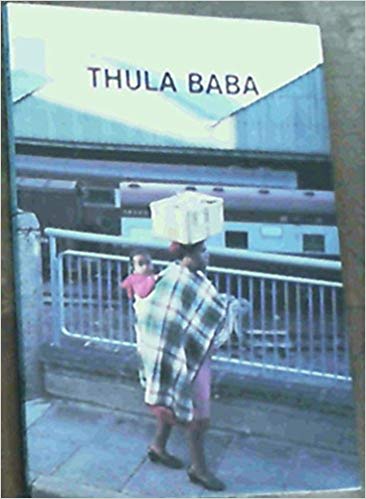
Thula Baba (1987)
• Joe Alfers’ photographic essay, Fishing People of Kosi Bay, results in an exhibition of photographs shown at the Documentary Photographers Conference at the University of Cape Town.
• Cedric Nunn's exhibition, Stop the Killings, opens at the University of Durban-Westville, Durban.
• Omar Badsha curated an exhibition for the first cultural festival which was organised by the cultural desk of COSATU. The exhibition was held at the University of Witwatersrand (Pictures) as part of the Congress of South African Trade Unions (COSATU) national congress.
• On the 20th December, the exhibition and catalogue The Hidden Camera opened in Amsterdam. Photographers' work that was on display consisted of Paul Weinberg, Peter Magubane, Cecil Sols, Vuyi Mbalo, and Omar Badsha. The exhibition was the first draft of Beyond the Barricades book and exhibition.
• Afrapix members exhibited work on Human Rights at the Market Gallery.
Members
• Pax Magwaza, Paul Weinberg, Santu Mofokeng, Rafs Mayet, Myron Peters, Jeeva Rajgopaul, Cedric Nunn, Cecil Sols, Vuyi Mbalo, Billy Paddock, Jabulani Sikhakhane, Chris Ledochowski, Sandi Smit, David Hartman, Gille de Vlieg, Herbert Mabuza
• Guy Tillim, Giselle Wulfsohn, Santu Mofokeng and Cedric Nunn became full-time members of Afrapix. Minutes designates the following people to be observers at the AGM meeting: Rafiq Mayet, Zubeida Vallie, Myron Peters, Jeeva Rajgopaul, Chris Ledochowski and Joe Alfers.
1988
• Anna Zieminski becomes a member of the Afrapix collective in Johannesburg.
• Ellen Elmendorp moved to Johannesburg where her first job was a picture editor at the independent photo agency Afrapix.
• Steve Hilton Barber becomes Afrapix's photographic editor and marketing manager.
• Omar Badsha was elected as chairperson of the Cultural Workers Congress, the Cape Town-based cultural group.
• Cape Town branch of Afrapix rented office spaces in Community House which also housed the UDF, the Cape Media Workshop and other anti-apartheid organisations.
• 10 July - Afrapix CC special meeting held at UCT to discuss new media regulations. The establishment of a photographic magazine was discussed. The magazine would be a separate company in which Afrapix could invest.
• A heavy state clampdown was imposed on the media and the imposition of censorship laws.
• Pax Magwaza lost his second appeal. This time he decided to flee to the “Independent” Transkei Homeland. After representation by his attorneys an agreement was reached with the authorities that if he would return to South Africa and serve a full month, his sentence would be regarded as completed.
• On the night of the 7th of July UDF activists, Zollie Malinga, Bulenani Ngcuka, Omar Badsha, Jonathan Shapiro, Rehana Rossouw, Veronica Simmers, Saleem Mowzer, Ngconde Balfor and Nams Wessels were detained for organising the Mandela 70th Birthday celebrations. The next day participants of the Documentary Photography Conference, which was organised by Omar Badsha, who had been head of the Centre for Documentary Photography, agreed that the conference was to proceed. The conference was held at the University of Cape Town.
• Santu Mofokeng joined the Institute for African Studies at the University of the Witwatersrand.
• 29-30 October - Afrapix held a special meeting and formed a subcommittee to draw up a new constitution. Omar Badsha, Diane Stuart (Co-ordinator) and Paul Weinberg were elected as members of this committee.
• In November, a proposal to publish a photographic magazine was tabled at an Afrapix meeting.
Exhibitions and Publications
• A joint project by Santu Mofokeng and Paul Weinberg, Going Home was launched in Johannesburg with the work showcasing in Pietermaritzburg as well as Grahamstown.
• Editing began for the Taking Sides exhibition which was funded by Oxfam and opened in the Netherlands (Venue, any other details. Posters, catalogues, photos – Link)
• 29 July - Omar Badsha’s exhibition, Prayers and Performance, opened at the Market Photo Gallery.
• ADA (Art, Design and Architecture) Magazine published a small feature on Afrapix in its 1988 issue No. 6

ADA No. 6 1988
• 30 Oct - 5 November - Staffrider has a retrospective exhibition of artworks and photographs including the launch of the Staffrider Anniversary Anthology.
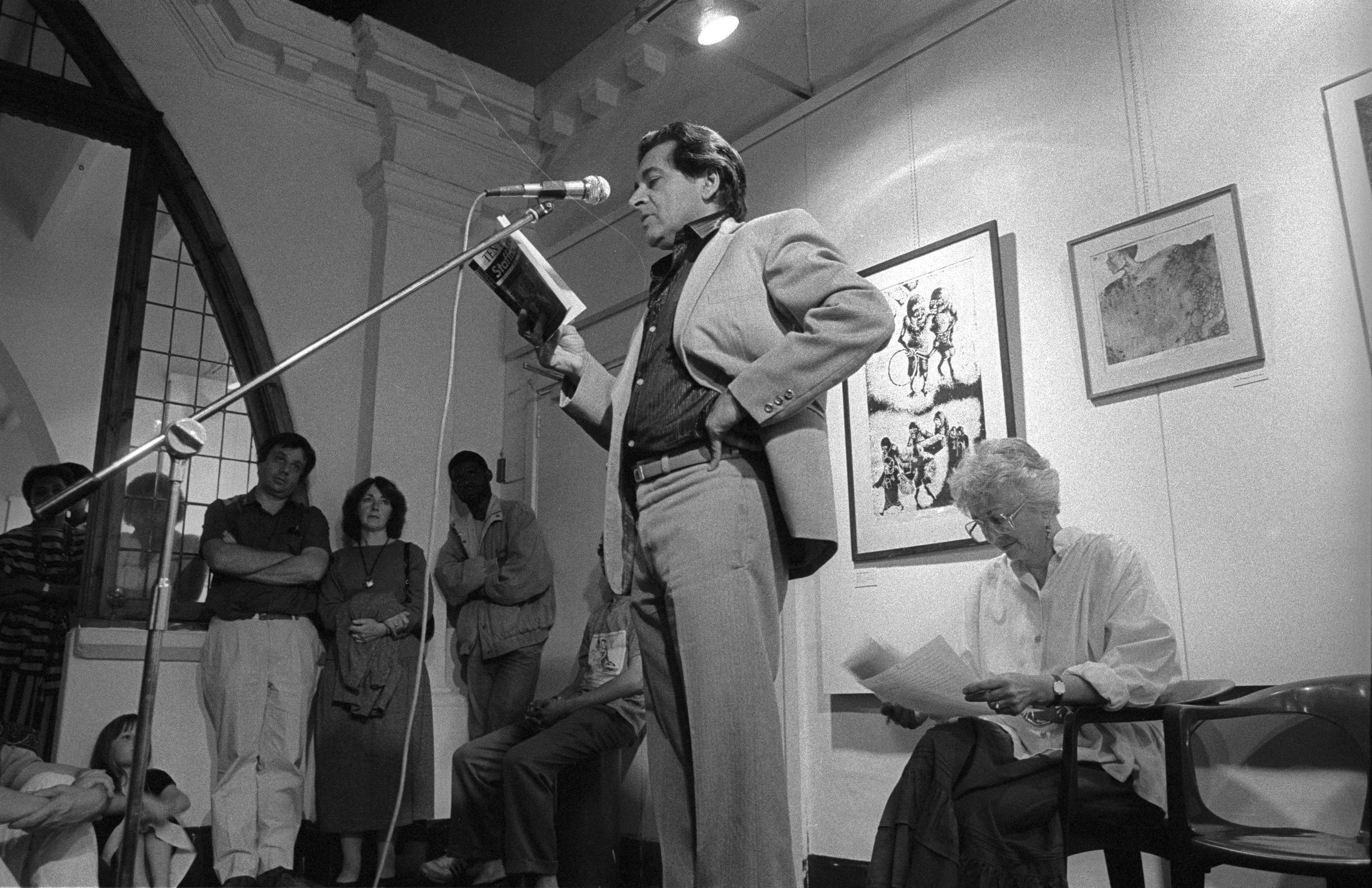
Writer Ahmed Essop speaking at Market Photo Gallery - 10 years of Staffrider exhibition and book launch 1988. © Omar Badsha
Members
Omar Badsha, Pax Magwaza, Paul Weinberg, Santu Mofokeng, Jeeva Rajgopaul, Cedric Nunn, Chris Ledochowski, Gille de Vlieg, Guy Tillim, Giselle Wulfsohn, Rafiq Mayet, Joe Alfers, Graham Goddard, Steve Hilton Barber, Deseni Soobben, Eric Miller, Anna Zieminski, John Liebenberg, Peter Auf de Hyder, Paul Grendon, Roger Meintjes, Chris Qwazi, Lesley Lawson
1989
• On Friday the 21st of April, Afrapix held AGM at the University of Cape Town. A major dispute arose on the tabling of two separate constitutions; one had been drawn up by Paul Weinberg and Diane Stewart and the other by Omar Badsha. Omar Badsha objected to the fact that he had circulated his draft to the two members of the subcommittee and had not received a response. Omar Badsha was surprised that Diane Stewart and Paul Weinberg had tabled their proposal without discussing their respective proposals before the meeting. Paul Weinberg had led an attack on Omar Badsha on several issues not related to the constitution. Omar Badsha walked out of the meeting and in his absence from the meeting a vote was taken to expel him from the organisation. The group decided to meet the following day at a different venue and when Omar Badsha arrived at the meeting he was informed that he could not attend because he was expelled. The decision to expel Omar Badsha emanated from a decision taken by a small group who felt that Omar Badsha prevented the organization from becoming a professionally run agency.
• Omar Badsha is summarily expelled from Afrapix due to objecting to a new constitution that was tabled without it being circulated before the Afrapix meeting.
• After been denied a passport for close on 25 years, Omar Badsha finally obtains a three months passport to travel abroad.
• Pax Magwaza is released from prison and moves to Pietermaritzburg where he continues his career as a photographer. He later applied for and was granted amnesty by the Truth and Reconciliation Commission (TRC).
Exhibitions and Publications
• Afrapix publishes a Cultural Calendar.
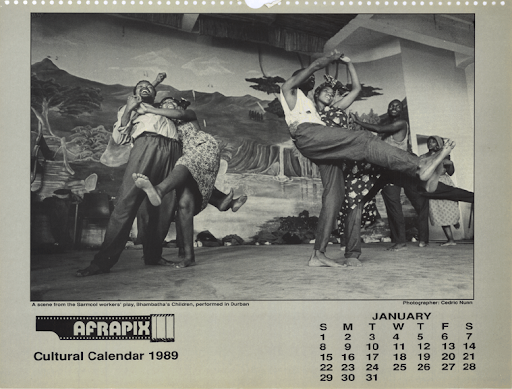
Afrapix Cultural Calendar 1989
The book, The Hidden Camera, is published by the CASA Foundation, showcasing thirty-two photographers. Twenty-one of the photographers were linked to Afrapix.
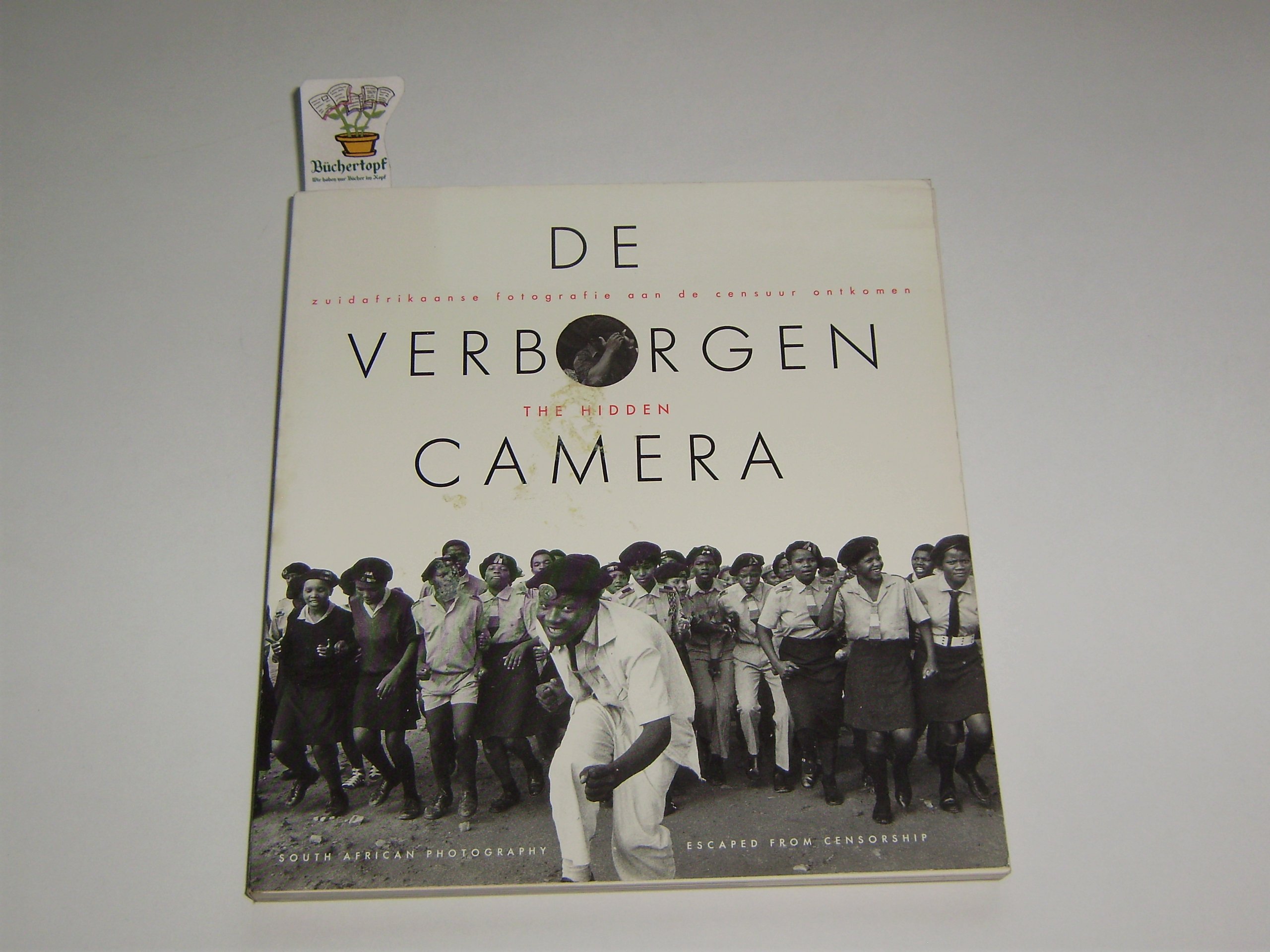
The Hidden Camera (1989)
• Afrapix's Steve Hilton Barber received a merit award for a photographic essay on Die Voelvry Tour. The series covered the alternative and dissident Afrikaans music scene.
• Paul Weinberg and Santu Mofokeng collaborated on a project, Going Home, an exhibition about their respective hometowns – the exhibition showed at the Tatham Art Gallery in Pietermaritzburg and also at Rhodes University as part of the Journalism Department in Cape Town. An interview with accompanying photographs on Going Home with Paul and Santu was published in Staffrider Vol. 8 No.2. 1989
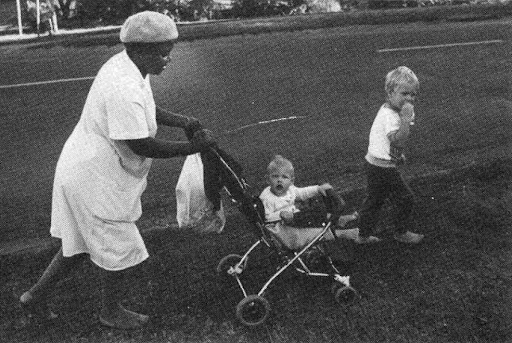 Going Home © Paul Weinberg 1989
Going Home © Paul Weinberg 1989
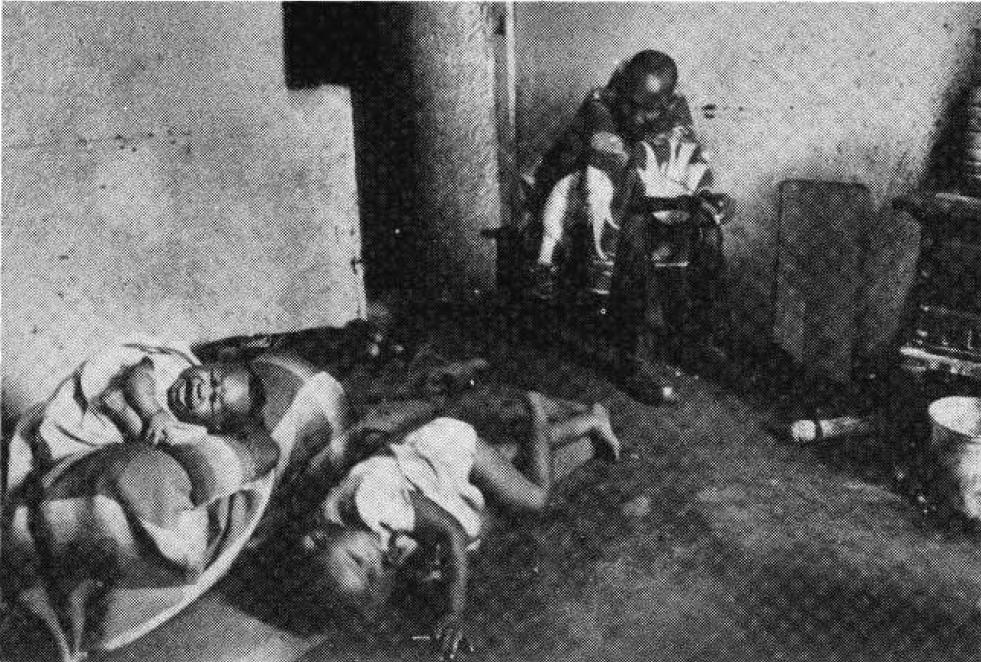 Going Home © Santu Mofokeng 1989
Going Home © Santu Mofokeng 1989
• Beyond the Barricades, an Afrapix project edited by Omar Badsha, Paul Weinberg and Gideon Mendel, is published by IDAF. It showed the work of twenty photographers, fourteen of whom belonged to Afrapix. The book was published with Lesley Lawson and Alex Harris as the editors because the editors were afraid that they could fall foul of the emergency legislation.
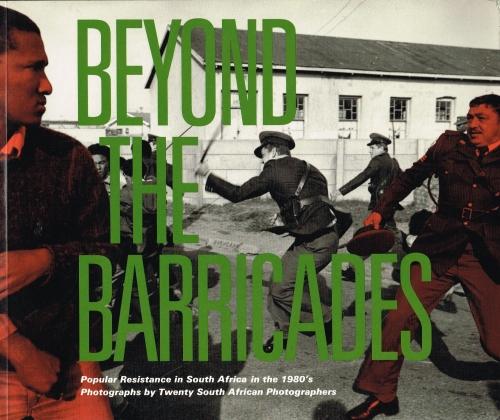
Beyond the Barricades (1989)
• Beyond the Barricades, the exhibition opens at the Market Photo Gallery, Johannesburg. Photographers that contributed to the exhibition were Omar Badsha, Julian Cobbing, Paul Grendon, Dave Hartman, Steve Hilton Barber, Rashid Lombard, Roger Meintjes, Gideon Mendel, Eric Miller, Santu Mofokeng, Themba Nkosi, Cedric Nunn, Billy Paddock, Myron Peters, Chris Qwazi, Jeeva Rajgopaul, Guy Tillim, Zubeida Vallie, Gille De Vlieg and Paul Weinberg.
• Paul Weinberg's book, Shaken Roots: The Bushmen of Namibia, is published by EDA publishers with text by Megan Biesele.
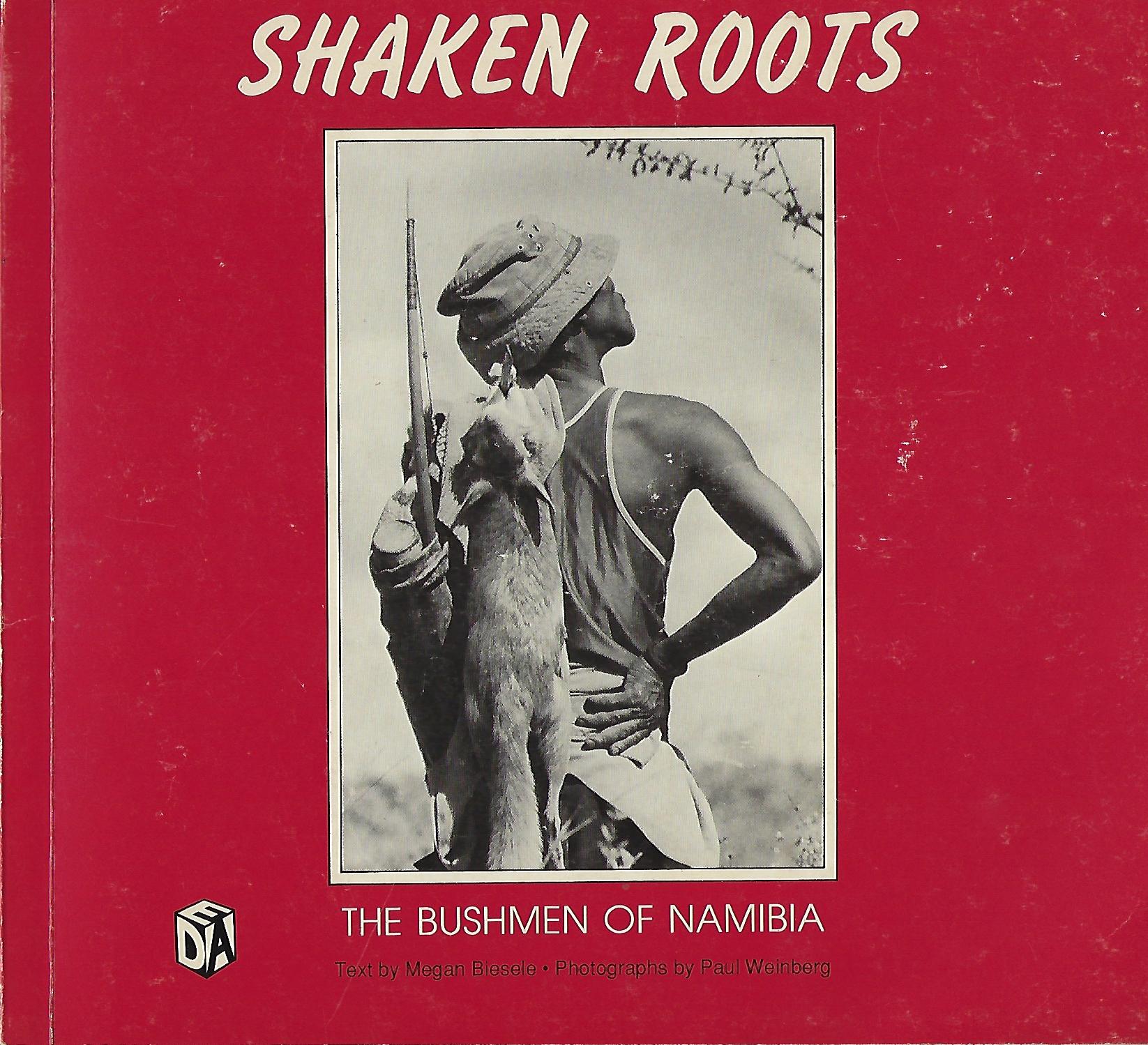
Shaken Roots: The Bushmen of Namibia (1989)
• 1st of October - Staffrider annual exhibition organized by Afrapix opens at the Market Gallery, Johannesburg
Members
• Paul Weinberg, Jeeva Rajgopaul, Cedric Nunn, Chris Ledochowski, Gille de Vlieg, Paul Grendon, Graham Goddard, Roger Meintjes, Pax Magwaza, Steve Hilton Barber, Eric Miller, Santu Mofokeng, Anna Zieminski, Guy Tillim, Gisele Wulfsohn, Peter Auf Der Heyde, Joe Alfers, Rafique Mayet, Deseni Moodliar, Chris Qwazi and John Liebenberg
1990
• Eli Weinberg and Ernest Cole offered a scholarship which was launched by the Centre for Documentary Photography. Jeeva Rajgopaul was awarded the Eli Weinberg Scholarship and the Ernest Cole Award went to Santu Mofokeng.
• The photographer, Ernest Cole, died in exile in New York 19 February 1990. Omar Badsha landed in New York in January and was in San Francisco on the 2 February. Omar Badsha left New York a few days after Ernest Cole passed away as he didn't have funds to change his ticket. Omar Badsha travelled to Harare and then to Lusaka.
• Steve Hilton Barber receives Staffrider Award for, Voelvry, a series on alternative, dissident Afrikaans music tour.
• Steve Hilton Barber receives the Institute of Professional Photographers Awards and Staffrider Award for Initiation series.
• Omar Badsha becomes the head of ANC Western Cape Arts and Cultural Desk.
• Paul Weinberg, Steven Hilton-Barber and Guy Tillim start removing their work from the Afrapix library. They, together with Eric Miller and Gisele Wulfson, met to discuss the formation of a new agency with David Goldblatt and the head of Leadership Magazine. Chris Ledochowski and Paul Grendon were also invited to the formation of South Light, but they were very uncomfortable by the fact that none of the Black members of Afrapix were invited to join the new agency and did not purchase any share in the new company.
• Roger Meintjes leaves the Afrapix collective and after the transition to a democratic government, moves into the field of museums and curating.
Exhibitions and Publications
• June - Afrapix published a photographic magazine called,Full Frame. Guy Tillim, Paul Weinberg and Steve Hilton-Barber were the co-editors of this 35-page magazine.
• All our Children, a joint Afrapix/Vumani exhibition is held at the South African National Gallery, Cape Town. Photographers included: Gill de Vlieg, Paul Grendon, Steve Hilton-Barber, Chris Ledochowski, Pax Magwaza, Roger Meintjies, Santu Mofokeng, Eric Miller, Cedric Nunn, Guy Tillim, Paul Weinberg and Anna Zieminski.
• Santu Mofokeng's first solo exhibition, Like Shifting Sand, for which he received an AA Vita Award Nomination, is held at the Market Gallery, Johannesburg.
• In November, Steve Hilton Barber’s photographic essay, The Savage Noble and the Noble Savages: Photography and an African Initiation engendered much debate and a great deal of controversy at the Market Gallery. Amid the controversy, the photographs were stolen from the walls of the Market Theatre's gallery.
Members
Paul Weinberg, Jeeva Rajgopaul, Cedric Nunn, Chris Ledochowski, Gille de Vlieg, Paul Grendon, Graham Goddard, Roger Meintjes, Pax Magwaza, Steve Hilton Barber, Eric Miller, Santu Mofokeng, Anna Zieminski, Guy Tillim, Gisele Wulfsohn, Peter Auf Der Heyde, Joe Alfers, Rafique Mayet, Deseni Moodliar, Chris Qwazi, and John Liebenberg
1991
• Graeme Williams started contributing to the South African documentary collective, Afrapix.
• Paul Weinberg, who was the only signatory to the Afrapix bank account, refused to have anything to do with Afrapix. This resulted in the agency to stop functioning.
• Jeeva Rajgopaul and Santu Mofokeng received the Eli Weinberg and Earnest Cole scholarship, which was organised by The Centre for Documentary Photography at the University of Cape Town, which was run by Omar Badsha, to spend three months studying photography at the International Centre for Photography in New York.
• The remaining members of Afrapix met to discuss closing down Afrapix at the end of June.
• On the 15th of June, the remaining members of Afrapix invited Omar Badsha and Paul Weinberg, as sole directors of the Afrapix C.C, to discuss the dissolution of the agency by the end of July 1991. Paul Weinberg did not attend the meeting and Omar Badsha signed the resolution.
• Many of the members including Paul Weinberg leave Afrapix and form a new photographic agency called Southlight, which later became South Photos.
• Full Frame magazine is incorporated into Vryweekblad (13 December 1991 – 10 January 1992).
• Centre for Documentary Photography closes due to a lack of funding and support from UCT.
